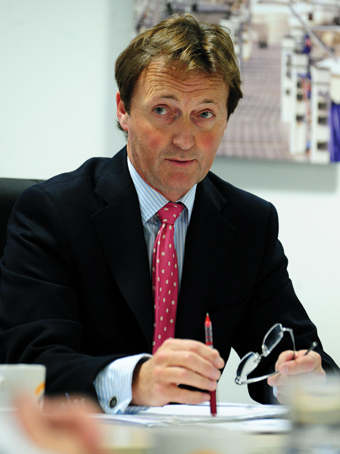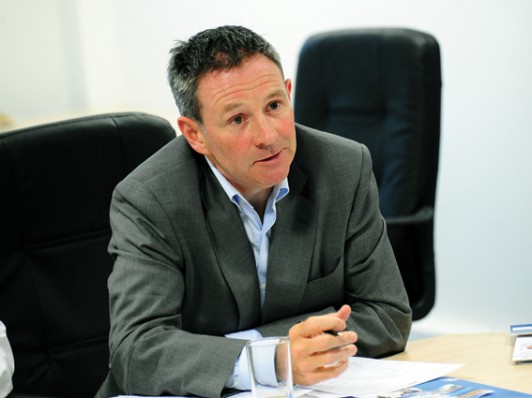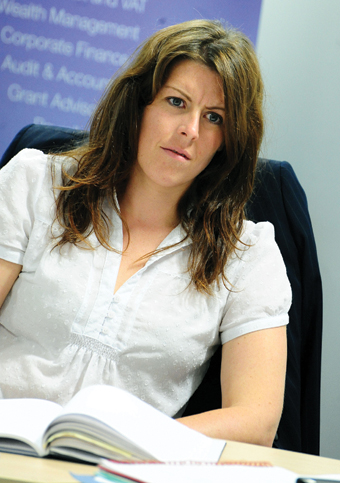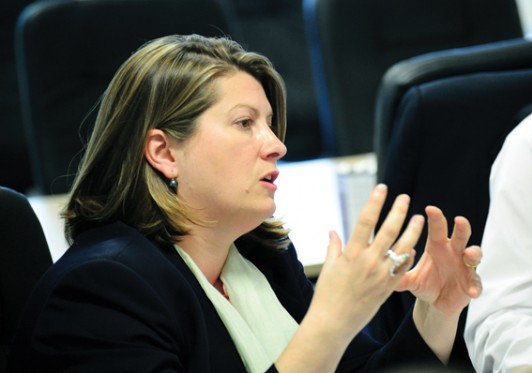The renewable energy sector and its opportunities for Cornwall were up for discussion recently in the big debate, sponsored by chartered accountants Bishop Fleming and held at Cornwall Marine Network’s offices
This article first appeared in the August/September 2011 issue of Business Cornwall magazine
The Government’s recent review of the Feed in Tariff (FIT) was always likely to be one of the dominant topics of the debate.
When the last Government first announced the FIT scheme last year, a solar ‘gold rush’ was widely predicted in Cornwall, with companies keen to capitalise on the huge financial incentives involved and take advantage of the best natural light conditions in the UK.
Whether it just underestimated the take up, or was just an unfortunate victim of the spending review, the Government effectively whipped the rug from under the feet of many business plans, by slashing the tariff for larger projects installed after August 1 by over 70%.
Tim German, renewable energy and partnerships manager at Cornwall Council, conceded that the Council saw the FIT as a huge economic opportunity, not just for the solar industry in Cornwall, but for itself as well.
At a time when the Council was having to make deep public spending cuts, it was planning a 5mw installation of its own in Newquay.
“Literally hundreds of sites were being looked at,” said German. “30 applications had been granted in Cornwall with many more in pipeline.
“As a Council we didn’t want people coming in on a hit run exercise, we wanted to use local jobs and skills as much as possible, and get local supply chain activity going here as well. People who have already invested a lot of time and money are going to be very badly affected by this.”

German said that the Council had “immediate discussions” with the Government about the review. “But they stuck to their guns,” he said, “and now the top level has been reduced from 5mw to 50kw – a huge difference.”
Andrew Honey, founder of Torpointbased renewable energy supplier and installation company Microgeneration, expressed his unhappiness with how the ‘consultation process’ for the review had been carried out. And he pointed to Germany being a model example of how a renewable energy policy should be managed.
“The Germans see the solar market as a massive industry,” he said, “and frankly just don’t understand why we haven’t managed it better in that respect.
“I was at the Intersolar trade show recently – 20 massive halls filled with technology, equipment, jobs and all the supporting infrastructure.”
Honey said that while he understood the economic challenges the country faces, the decision to so dramatically reduce the tariff for larger projects is not going to create the sort of industry they have in Germany.
“It’s just going to create small scale mom and pop type capability,” he said.
“And if we want to see manufacturing and other supply chain stuff we really need to go back to it. I believe it will come back in another form, I believe ministers didn’t understand Photo Voltaic (PV) at the time.”
Katie Ashworth, a renewables specialist at law firm Murrell Ashworth, also agreed that larger projects would return as technology prices came down, but voiced her concern at the damage in credibility to the UK energy market on the world stage.
Jonny Gowdy, programme director at south west renewable energy agency Regen SW, felt that the Government reaction was one of “panic”, but conceded it was the Treasury rather than Department of Energy and Climate Change (DECC) that was pulling the strings.
His biggest fears now, however, wasn’t what the Government had just done, but what it might do in the future, with the findings of a further review set to be published next April.
He told the panel: “We’re already getting feedback that Government is not just looking at tariff levels but the structure in which the FIT is being set up – linking it with energy efficiency measures, which on the face of it could be a good thing, but it could also create extra hurdles making it more difficult to get the FIT and also making it more difficult for small companies that specialise in PV to offer the full services that you would need to achieve energy efficiency.
“I wouldn’t want the large insulation companies coming down and picking off all the microgeneration work we can do.
Getting the message
The panel was unanimous in its belief that more consistency was needed from the Government in their message.
Andy McKenzie, business development manager at environmental business specialist Low Carbon Futures, believes damage has already been done.
“After years of good work building up the reputation and case for the FIT,” he said, “all of a sudden business confidence has been knocked and they don’t want to know. Businesses don’t want to even consider energy efficiency measures at the moment. They are keeping at arm’s length away from it, especially after the economic times we’ve had.”

Ashworth believes the Government may have been scared off by the initial excitement that the FIT generated. She likened the Cornish solar gold rush, to onshore wind in Scotland a few years back, where, she says, only 7% of options were actually taken up. She said talk of a “£1 billion” solar rush was never going to happen, and that the Government was frightened off by this potential demand and consequently reeled the tariff in.
“The lesson to be learned is not to overplay these things,” agreed Gowdy.
“It sends the wrong message to Government and they do over react. We should deal with facts and evidence.”
West Cornwall MP Andrew George admitted that the Government could have handled it better, but in the wake of the cutbacks, a review was inevitable. And he agreed that there needed to be a consistency in message.
“The industry needs to have confidence where it’s going,” he said, “but the Government clearly understands this.”
Gowdy disagreed with George on this point, however, pointing out to a recent briefing meeting over next year’s review.
“They warned there would be changes to FIT level and structure but said they didn’t know what the changes would be, but they were thinking of all sorts of things. In terms of sewing uncertainty, we came out of that meeting thinking ‘crikey’.”
Ashworth echoed that investors into the market always expected a review and understood the economic climate, but it was the rush into the review and the uncertainty created that had shaken them.
“If it had been more structured,” she said, “they would have understood. They fully expected the FIT to be brought down in 2012/13, but weren’t expecting it to be hijacked in 2011.”
Ewan McClymont, director of corporate development at accountancy firm Bishop Fleming, said the Government had underestimated demand. He said: “They are actually blaming the industry for the take up which has been spectacular. If you look at the figures, they are so skewed towards encouraging large scale arrays, it’s no wonder it was so popular.”
There was also confusion as to whether the Government ever had a fixed budget for the FIT. George said there was an “implied budget” while German admitted that budget figures were “really a grey area”.

German said the review effectively killed off the larger scale schemes in Cornwall, for the time being at least.
“The price of technology is coming down all the time,” he said. “We always anticipated a digression rate of the tariff to reflect the price of technology coming down. But to offer only 8.5p per kw hour compared to what it previously was, about 29p, is quite a derisory amount.”
He said that “other mechanisms” needed looking at to try and get the larger scale schemes back on track.
“The Council is revisiting its plans at the moment,” he said. “There are two reasons why we wanted to build one, one is to make money to support activities as a council, and secondly because of leadership, where we can demonstrate leadership in a renewable world which we think is very important. The Council’s own site is still being considered as a long-term basis.”
Cornwall – a centre for UK renewables?
Wind, waves, sun, Cornwall also apparently has the perfect conditions to progress geothermal, or ‘hot rocks’ power. But how realistic an aim is it for Cornwall to become a UK centre for renewables?
Ashworth said one of the problems is that Cornwall often works “in a disparate way, working in small pockets”.
She commented: “Sometimes I look at it and wonder whether Cornwall really wants to challenge the likes of Scotland who are really starting to plough forward. We need to have more joined up thinking and a county-wide conversation that takes in wave, wind, solar etc. We have an abundance of resources which other areas just don’t have.” Gowdy added: “We need to put it into perspective, the south west is pretty small beer in terms of mega watts produced. At the moment the south west has just over 200mw installed. 200mw is a medium-sized wind farm in Scotland.
And that’s after five years of growth. “But what we do have is niche areas – PV is one area, geothermal is another area. Wave energy in particular is another area where we can be leaders, but in terms of scale of market, still quite small.”
But in terms as a centre for knowledge and expertise, particularly in marine renewables, Gowdy said Cornwall and the south west can be a leader, pointing to the calibre of company already operating in the market such as Mojo Maritime, Seacore, KML, and A&P.
Amanda Pound, marine renewables services manager at A&P Falmouth, agreed and highlighted the “joined up thinking” already taking place in her sector.
She said: “We have all the skills on the marine side of renewables down here in the south west.
“We often hear about the domination in Scotland which has an incredibly strong presence, but we now have our own voice as well and have demonstrated we have all the skills down here and the physical resources as well. And that joined up thinking is starting to come through.”

German said there was great potential for the Cornish marine renewables sector.“You have the here and now,” explained German, “which is wind and solar; the mid-term, which is geothermal, a proven technology and we have the best resources in the UK and two sites which have planning permission; then you have the longer term which are our marine resources, and those are the discussions where the real interest lies at the moment.”
George said the renewables industry needed a clear strategy. “We need a written down and agreed ambition on where we are going to go in next 20 years,” he said. “I would like to see a clear indication from the sector where the main opportunities are, which can then be taken to Government so they can see where help is specifically needed.”
McKenzie was in no doubt that Cornwall can become a true leader in renewables, and it wasn’t just about scale.
He said: “A long time ago the Cornwall Sustainable Energy Partnership got the ball rolling, companies like Microgen were ahead of their time, long before the FIT was making a case for the market. I think with the smart grid idea, with a lot of rural communities being on the end of a piece of string, Cornwall has huge opportunities to embrace this concept, when looking at generation and grid management.”
Pound called for a regional centre of excellence. “We should be looking at a renewable energy park in the south west for all renewable energies,” she said, “with a 20-year road map that shows how we are going to utilise microgeneration now.”
Honey said he was encouraged by the Council’s apparent commitment to a low carbon economy. “What has been created has been a breath of fresh air,” he said. “Cornwall uniquely has a baseline carbon map, and a programme Clear about Carbon, explaining where carbon fits in with the procurement cycle. We need to make this message more explicit, but the elements are starting to come together.”
McClymont added: “Cornwall has all the ingredients and has gone a long way down the road with the Council and the development company in formulating a strategy to make the county more energy efficient.”
But he warned that a clear message needs to the sent to the Government, for less tinkering and more encouragement.

Question of finance
One of the main reasons that the FIT came in the first place, of course, is that the UK has EU carbon targets to meet.
By 2020, 15% of the country’s power must come from renewable sources. But to give you an idea of how far ahead Germany is, that’s a figure it has already moved past. It is looking at 80% by 2040.
Germany is committed to the renewable generation, it has even announced that it is decommissioning its nuclear power stations, at a time the UK is investing in new ones.
Ashworth said the German market enjoys a far greater public awareness and positive support than here in the UK. Access to finance and investment is also considerably more straightforward, with charges that the banks in the UK just don’t understand the market.
It is a common issue, according to McClymont. He said: “If you are a domestic homeowner, with £15k sitting around the bank, solar panels are an absolute no brainer. But for a business, a 50kw installation will cost at least ten times that, which is a big ask for a company when banks won’t lend.”
And the banks feel vindicated in their decision not to lend, says McClymont, when the Government cuts its tariffs.
Gowdy said that banks don’t understand renewable energy projects on any level and that’s a real problem. He expressed the hope that the Government’s Green Investment Bank initiative will change that scenario.
“We’re hoping the Green Investment Bank will have real credibility and a capability to do proper due diligence,” he said. “It will then perform a function of what we call crowding in – if the Green Investment Bank is investing, it should be a signal to all the other investment bodies.”

However, the Green Investment Bank isn’t due to be up and running until 2016.
“There is a lease mentality among banks,” said Gowdy. “They’ll happily lend money to a farmer to buy a tractor, because if push comes to shove they can go and get the tractor back. But PV panels on someone’s roof are practically valueless.”
McKenzie added: “We’ve had so many issues of banks coming to us and saying what if FIT stops, what’s the saleable value of the installation? And it’s not just the banks. Independent financial advisers as well. It can be hard to find IFAs who will even discuss it with clients.”
The panelists agreed that Government does appear to like to over complicate things with its green policies. The forthcoming Regional Heat Incentive was touched upon, but again criticised as being “over complicated”.
Gowdy said: “All these complicated polices are because we’re frightened to bite the bullet and have a proper price of carbon. If we did that, we wouldn’t need all these complex policies to encourage business to do all these energy efficiencies. Carbon costs money, let’s just have this standard tax and grin and bear it.”
All at sea?
Cornwall’s marine resources arguably hold the greatest potential for the Duchy to become a leader in a part of the industry very much still in its infancy.
The Wave Hub has seen considerable investment already (some £40M+). But despite it being deployed and ready for action, we find ourselves in the slightly strange predicament of it currently lying redundant on the sea bed, waiting for the rest of the technology to catch up.
Gowdy said a few developers were at the cusp but the technology was nowhere near where it was expected to be. “A few years ago the industry was saying we need Wave Hub, we need it now,” he said. “Now we’ve got it, there is a bit of a hiatus.”
Pound admitted that there were currently no developers ready to plug into Wave Hub, but said a pre-commissioning testing facility in Falmouth harbour – FabTest – could soon help change this.

She said: “We have people waiting to come on to the site. Once up and running, I think we’ll see a much clearer road map leading up to utilisation of Wave Hub. Testing devices on a small scale close to the dockyard, reduces the risk and developers will be able to really understand what will happen.
“There is a huge focus on bringing technology forward.”
“The marine renewable energy industry is really interested in the south west, no doubt about that,” said German, “and in Falmouth and Hayle in particular. Developers are really switched on to having a pre commissioning site like FabTest.”
George also voiced his optimism for the marine renewable sector, and said while there were no devices currently attached to Wave Hub, a lot of businesses in the south west were already working in offshore wind.
“I am concerned we don’t lose too much time,” he said. He also touched upon the issue of funding for Wave Hub, and Renewable Obligation Certificates (ROCs).
“If the ROC review is there to review the climate in which these things are going to be brought forward, it might be worthwhile constructing arguments for a justification of a unique financial driver for the Wave Hub project.”
Honey agreed and that it should be done quickly that things should progress because Europe is bound to provide competition for Wave Hub.
Ashworth made the point that the marine renewables industry could be a good project for the fledgling Cornwall and Isles of Scilly LEP to get its teeth into. “It is a fantastic opportunity,” she said. German reported that he and Jonny Gowdy had already met with the LEP chairman to raise the issue. Gowdy said it was important that additional funding was sought for projects like Wave Hub.
“Assuming we get parity on the ROCs in the market, the onus is on us to attract additional investment and we need to give that signal that we are prepared to do that. Then all the other things we have, Grid, ports, supply chain, skills, infrastructure, all those come to bear and we’re in a really good position.”
He suggested some private businesses could even perhaps be encouraged to pay a premium for local marine energy. “If companies like Tesco’s and Sainsbury’s had a plaque on the wall saying “We’re powered by Cornish wave power”, that could be attractive.”
The future
The panel was agreed that there is huge potential for the renewables market in Cornwall, but there is a long, long way to go. Renewable energy on a larger scale was needed, but Government policy and spending cutbacks made the picture a little unclear.
Gowdy said: “A report published a couple of years ago said to meet the targets for 2020, a mix of renewable energy is needed and we would need to be looking at over 7GW. Considering we are now at just over 200mw, the first message is that there’s a long way to go.
We need some big things. “There’s a mountain to climb, but it is do-able. But our projection was based around the policies that were in place in 2008, pre FIT and pre RIH. FIT coming in has improved things, but now the FIT has changed, I’m not sure.”

While all the work behind renewable power sources was all very encouraging, McKenzie pointed out that we shouldn’t forget about conserving what we’ve already got.
“Energy efficiency has almost become a dirty word,” he said. “But it should be efficiency first, and then generation.”
Honey agreed and said that it made good economic sense to lower your energy costs and take a good review of what you’ve got. “You’ll be surprised at what you will be able to flush out,” he said.
“My concern is we’re making life very expensive for ourselves in the future because we’re not doing the right things now. We must get out of that short-term quarterly report type attitude.”










[…] from: The Big Debate: Sustainable energy – open in a new […]
Comments are closed.